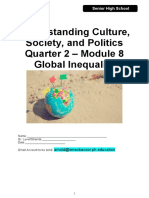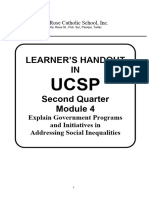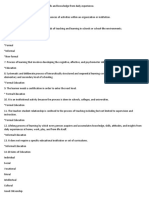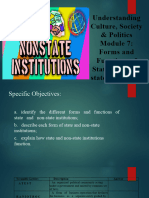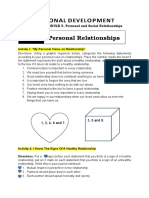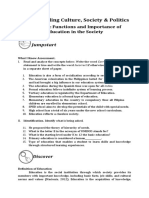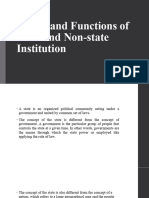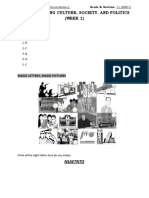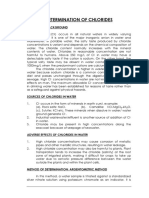Senior High School
Understanding Culture,
Society, and Politics
Quarter 2 – Module 9
Cultural, Social, and
Political Change
Name: ________________________________________________________________
Gr. 12 Strand: ________________________ April 8, 2021
Gmail account. arnold@smacbacoor.ph.education
1
� What I Know
PRETEST
Multiple Choice. Encircle the letter of the correct answer.
1. Social movements help bring about social change. This statement is ______.
a. true c. neither a nor b
b. false d. a, b, and c
2. Social change can be
a. Political c. scientific
b. social d. a, b, and c
3. Population change may affect the environment and the natural resources.
Environmental changes also affect people and the society. Therefore, we can
conclude that:
a. Population growth has a negative effect in the environment.
b. Individuals and the environment affect each other.
c. Disasters are caused by people themselves.
d. The continuous growth of world population increases the possibility of
more natural disaster.
4. The following are causes of social changes except:
a. tensions c. technology
b. modernization d. environment
5. This refers to the view that all genders including men and women should
receive equal treatment and therefore should not be discriminated based on
their gender
a. ethnic conflict c. feminist movement
b. Gender equality d. racial discrimination
6. It refers to the use of new techniques to achieved desired end.
a. diffusion c. assimilation
b. acculturation d. innovation
7. Ethnic conflict and civil war
a. means the same c. usually happens together
b. is different from each other d. prevails in Asian countries
8. Gender issue is an example of
a. innovation c. social tension
b. assimilation d. social movement
2
�9. It refers to transmission of cultural characteristics or traits from the common
society to all other societies
a. diffusion c. technology
b. assimilation d. acculturation
10. It is an armed conflict between different ethnic groups
a. revolution c. inter-ethnic conflict
b. civil war d. terrorism
11. It is a process of systematic cultural change of a particular society
carried out by a new or another dominant society
a. assimilation c. revolution
b. acculturation d. terrorism
12. The following are causes of social change except:
a. social institutions c. modernization
b. innovation d. gender issues
13. It refers to changes made in cultural elements, both material and non-
material.
a. social change c. cultural change
b. population change d. political change
14. It occurs when nonstate actors use violence against civilians to achieve their
political goals
a. crime c. civil war
b. revolution d. terrorism
15. It involves a public seizure of the state with the main goal of overturning the
existing political structures
a. revolution c. inter-ethnic conflict
b. civil war d. terrorism
3
� Lesson Cultural, Social, and Political Change
1 Learning Competency Identify new challenges faced by human
populations in contemporary societies
(UCSP11/12CSC-IIh-33)
What’s In
How’s your travel around the world? Were you able to notice more
inequalities? Well, do not worry too much because you find ways to address global
inequality. Moreover, you filed a bill to help solve this problem. Right?
Loosen up! Be stress free as we take another step to start our next module.
What’s New
Activity 1: TANGLED
Arrange the tangled letters until you get the right term.
No. Tangled Words Answer
1. coslia agecnh social change
2. lulucrat nheagc cultural change
3. acitolpil hcnaeg political change
1
� What Is It
Any shift in various aspects
of the society means change.
Social change refers to the
significant modification or
alteration in the lifestyle of a
society, including culture. Social
change also means any significant
shift or modification in the lifestyle
of the society that affects the
major portion of the population that
brings about pattern of behaviour.
It may be brought about by
cultural, religious, economic,
Image: https://bit.ly/2UAHr8F
scientific, or technological forces.
“Staying at home and the “new normal” because of covid-19 are the best examples
for this. Any change of what we perceived as a normal thing in our lives, may it be
intentional or not, may lead to social change.
Cultural change refers to changes made in cultural elements, both material
and non-material.
Political change is when there is a significant disruption in a government that
leads to new or modified leadership or policies.
CAUSES OF SOCIAL CHANGE
Technology. According to Thomas Friedman, American political
commentator and author, technology is the driving force behind globalization. People
get connected all over the world through technology. Technologically advanced
countries are on the rise. Technology contributes a lot to the modernization in the
fields of medicine, agriculture, manufacturing, and other industries. Life has been
made easier through technology. But, it can’t be denied that while technology has
given so much comfort to us, there is also its downside. To name a few, it helps
widen the gap between the technology savvy and those who are not. It can also
bring security risk in terms on data privacy issues, online scam, online hacking,
phishing, systems failure, and the like.
Social Institutions. Social institutions are established sets of norms and
subsystems in a society. Societies are composed of different sectors and each
sector carries out specific tasks. Each sector also has different responsibilities that
contribute to the normal functioning of the society. Each change in a single social
institution, also leads to changes in all other institutions. For instance, the change in
technology has led to changes in other social institutions. The introduction of
2
�machineries to be used in factories has led to a change in the acquisition of the
workforce where there are only few individuals are needed to run an industry than in
a manual work set-up.
Population. A change in population in the composition of every level in the
society leads to social change. Regardless, whether the population increases or
decreases, for sure it has a great impact of all aspects in the society.
Environment. A population change may affect the environment and the
natural resources. Likewise, a change in the environment will also affect the people
and the society. Because of the changes in the population (increase), people will
now be using all the natural resources available. The way human interact with the
environment and the way members of the population utilize the resources aggravate
the impact of those natural disasters.
Modernization may also be considered as atypical result of social change. It
refers to the process of increased differentiation and specialization within a society,
primarily around its industry and infrastructure.
SOURCES OF CULTURAL, SOCIAL AND POLITICAL CHANGE
Innovation. It is the use of new techniques to achieve desired ends. It also
refers to changing or creating more effective processes and ideas. This is the
process of translating a new idea into something that can create value.
Cultural Diffusion. This is the spread of culture including aspects such as
clothing and food, from one group to another, typically as a result of making contact
with a new group for the first time. When one culture begins to adopt elements
(clothing, food, religion, costume, song, dance, language, etc.) of another culture,
then cultural diffusion happens. Filipinos experience cultural diffusion when KPOP
was first introduced in the Philippines. The concept of KPOP music and K drama
was new to us at that time.
Acculturation. It is a process where a minority (small group of people) adopts
the cultural aspects of the majority (large group of people) without losing its own
traditions and customs. Looking back to our previous example about KPOP, many
Filipino millennial begin to speak and dress like their KPOP idol but they can still
retain their Filipino culture.
Assimilation. Assimilation is a process whereby people of a culture learn to
adapt to the ways of the majority culture. There is a loss of the minority’s own culture
as more value is given to the cultural aspects of the majority.
SOCIAL CONTRADICTIONS AND TENSIONS
Social contradictions and tensions apply only to humans. There are instances
that a new idea somehow may lead to innovation, but instead, it can disturb patterns
and relationships between people, likewise, the encountering of other cultures may
lead to tensions and conflict.
3
� Inter-ethnic conflict is an armed conflict between different ethnic groups.
When two or more ethnic groups meet because they are occupying or living in the
same territory, there are so many possibilities that may arise. One of these is
misunderstanding between these groups that would likely lead to conflict and would
result to war.
Political violence can be the result not only of ethnic conflict but also of class
conflict. In political science, political violence is also seen as a manifestation of
aggressive politics, and it includes revolutions, civil war, riots, strikes, and peaceful
protest movements. Two of the more serious forms of political violence are
revolution and terrorism.
Revolution involves a public seizure of the state with the main goal of
overturning the existing political structures. Revolutions involve the public, and are
usually attended by rapid, structural changes that usually involve the use of violence.
Terrorism occurs when nonstate actors use violence against civilians to
achieve their political goals.
Gender issue is also a source of social contradictions and tensions. The
issue on gender equality has been a subject on social discussions for quite some
time up to the present. Gender equality refers to a view that all genders, including
men and women, should receive equal treatment, and therefore should not be
discriminated against based on their gender. UNICEF (United Nations children’s
Fund) describes gender equality as “women and men, and girls and boys, enjoy the
same rights, resources, opportunities and protections. It does not require that girls
and boys, or women and men, be the same, or that they be treated exactly alike.
What’s More
Activity 2: “NOON AT NGAYON”
Due to the changes brought by technology, there are many
inventions/innovations used by human that make lives easier. You are to provide the
old invention and the new innovation. Number one (1) is already done for you.
Noon Ngayon
1. typewriter computer
2. lamp/lampara lightbulb
3. herbal medicines syrup/tablets medicine
4. kalesa cars
5. compass google maps
4
� 6. telegraph messenger/email
7. radio/newspaper internet
8. ____________________ ____________________
9. ____________________ ____________________
10. ____________________ ____________________
Activity 3: CHANGES IN MY COMMUNITY
1. Briefly describe the community where you presently live.
2. Enumerate five (5) changes that you observed in your community for the last
five (5) years.
Description of my own community
Our community nowadays is still the same as before. but because of the virus the
barangay are more strict to avoid the spreading the virus.
Changes in my community
1. My community has unity.
2. The people in my community, they love each other and work together.
3. My community has a cooperativeness.
4. Has beautiful and clean environment.
5. My community is peaceful.
What Have I Learned
Activity 4: MY THOUGHTS
What cultural, social and political changes that I have learned during covid-19
pandemic.
1. Everyone is mandated to wear face masks and face shields
whenever we go out of our houses.
2. Everybody should practice social distancing and avoid crowded
places.
5
� 3. It has been observed that a great number of worldwide leaders have
shown their support for each other in proactively beating this
pandemic.
What I Can Do
Activity 5: THE NEW NORMAL AND BEYOND
As a learner, what are you going to do as a response to this social change of
the so-called “new normal”? Enumerate and briefly explain your answer. Give five (5)
answers.
1.) Follow the protocols
2.) Enhance my faith in God
3.) I will familiarize myself in this new normal's daily living.
4.) I will obey my parents command.
5.) Help others to continue fighting
Explanation:
1.) This so-called new normal that we are experiencing is because of the pandemic
which kills billions of people around the world and as a response I will help to prevent
the spreading of this virus even in a simple way by following the protocols.
2.) For us to be able to pass this challenge, we should always remember our dear
God and ask guidance from him because he is the most powerful amongst all.
3.) It is important for us to practice ourselves in the activities/ daily lifestyle under this
new normal until it ends for us to understand the situation and still active despite this
pandemic.
4.) I will obey my parents command because I know that they were just concerned
and they are more knowledgeable about my safety especially this time.
5.) As I observed in my surroundings, in the social medias, newspaper, radios and
etc., most of the people were hopeless and for them it is the end of the world so I will
try my best to encourage them to fight and I will start doing this to my friends, family,
and post it on my social accounts.
6
� SUMMARY
Social change refers to the significant modification or alteration in the lifestyle
of a society, including culture. Social change also means any significant shift
or modification in the lifestyle of the society that affects the major portion of
the population that brings about pattern of behaviour.
Cultural change refers to changes made in cultural elements, both material
and non-material.
Political change is when there is a significant disruption in a government that
leads to new or modified leadership or policies.
Causes of social change include technology, social institutions, population,
environment, and modernization.
Sources of cultural, social and political changes include innovation, cultural
diffusion, acculturation, and assimilation.
Social contradictions and tensions include inter-ethnic conflict, class struggle,
armed conflict, terrorism, protests, and gender issues.
7
� ASSESSMENT
POSTTEST
Multiple Choice. Encircle the letter of the correct answer.
16. Social movements help bring about social change. This statement is ______.
a. true c. neither a nor b
b. false d. a, b, and c
17. Social change can be
a. Political c. scientific
b. social d. a, b, and c
18. Population change may affect the environment and the natural resources.
Environmental changes also affect people and the society. Therefore, we can
conclude that:
a. Population growth has a negative effect in the environment.
b. Individuals and the environment affect each other.
c. Disasters are caused by people themselves.
d. The continuous growth of world population increases the possibility of
more natural disaster.
19. The following are causes of social changes except:
a. tensions c. technology
b. modernization d. environment
20. This refers to the view that all genders including men and women should
receive equal treatment and therefore should not be discriminated based on
their gender
a. ethnic conflict c. feminist movement
b. Gender equality d. racial discrimination
21. It refers to the use of new techniques to achieved desired end.
a. diffusion c. assimilation
b. acculturation d. innovation
22. Ethnic conflict and civil war
a. means the same c. usually happens together
b. is different from each other d. prevails in Asian countries
23. Gender issue is an example of
a. innovation c. social tension
b. assimilation d. social movement
8
�24. It refers to transmission of cultural characteristics or traits from the common
society to all other societies
a. diffusion c. technology
b. assimilation d. acculturation
25. It is an armed conflict between different ethnic groups
a. revolution c. inter-ethnic conflict
b. civil war d. terrorism
26. It is a process of systematic cultural change of a particular society
carried out by a new or another dominant society
a. assimilation c. revolution
b. acculturation d. terrorism
27. The following are causes of social change except:
a. social institutions c. modernization
b. innovation d. gender issues
28. It refers to changes made in cultural elements, both material and non-
material.
a. social change c. cultural change
b. population change d. political change
29. It occurs when nonstate actors use violence against civilians to achieve their
political goals
a. crime c. civil war
b. revolution d. terrorism
30. It involves a public seizure of the state with the main goal of overturning the
existing political structures
a. revolution c. inter-ethnic conflict
b. civil war d. terrorism
9
��11
